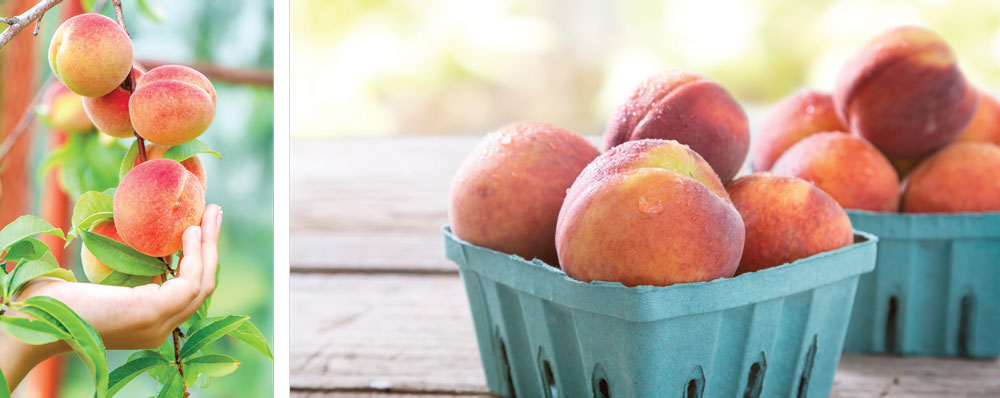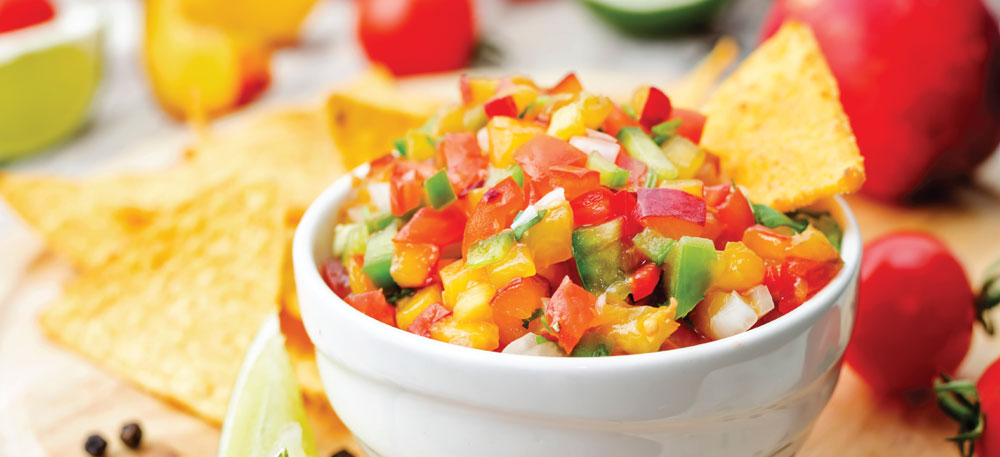PEACHES
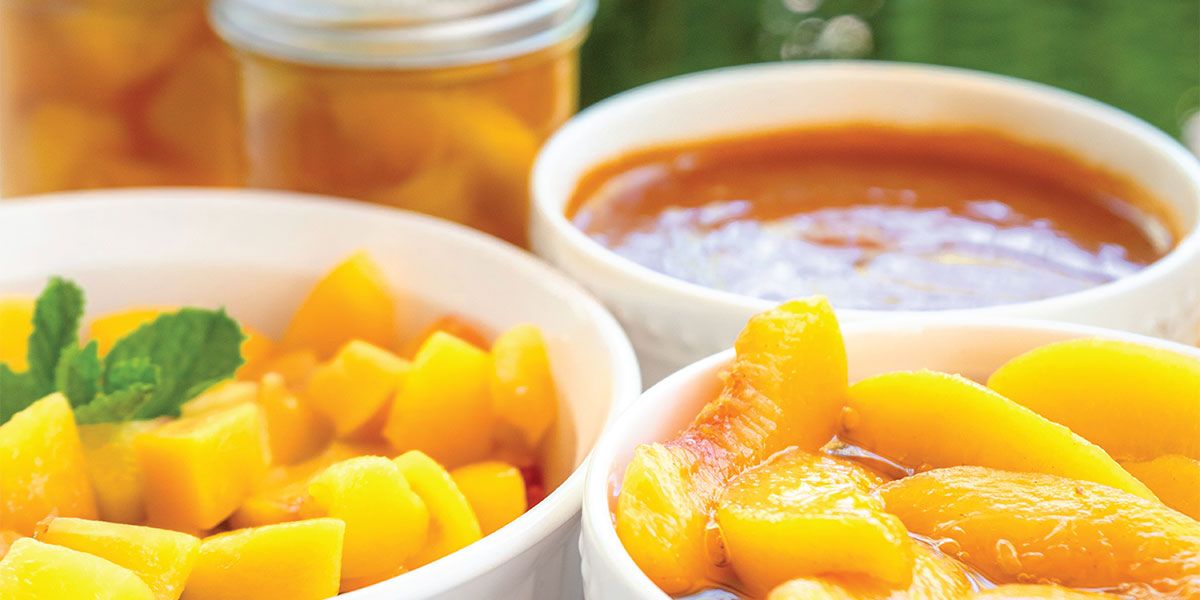
Photo: James River Media
The jewel of summer
Nothing says summer quite like biting into a peach so perfectly ripe and luscious that the sweet juice runs down your hands and arms. Those fuzzy gems are quintessentially summer, lending themselves beautifully to both sweet and savory presentations.
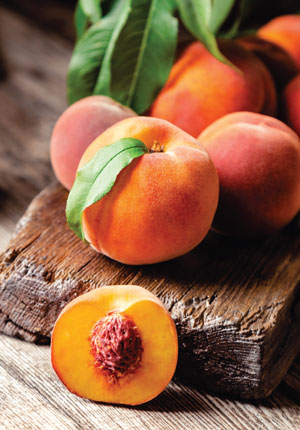 The oldest domesticated fruit we have, peaches originated in China at least 4,000 years ago. The Chinese (who are still the biggest peach producers in the world), hold peaches in high regard as a symbol of longevity, immortality and good luck.
The oldest domesticated fruit we have, peaches originated in China at least 4,000 years ago. The Chinese (who are still the biggest peach producers in the world), hold peaches in high regard as a symbol of longevity, immortality and good luck.
The center of the peach contains a hard shell, also known as its stone, which protects the seed. This stone makes for easy long-term storage, allowing peach seeds to become popular for trading on the Silk Road, enabling them to find their way to Europe and later, North America. Introduced to the New World by Spanish Conquistadors, peach trees quickly sprung up in Georgia, the Carolinas and Virginia. Native Americans were early adopters of the peach, and it was their cultivation that led to peaches being introduced across the Americas.
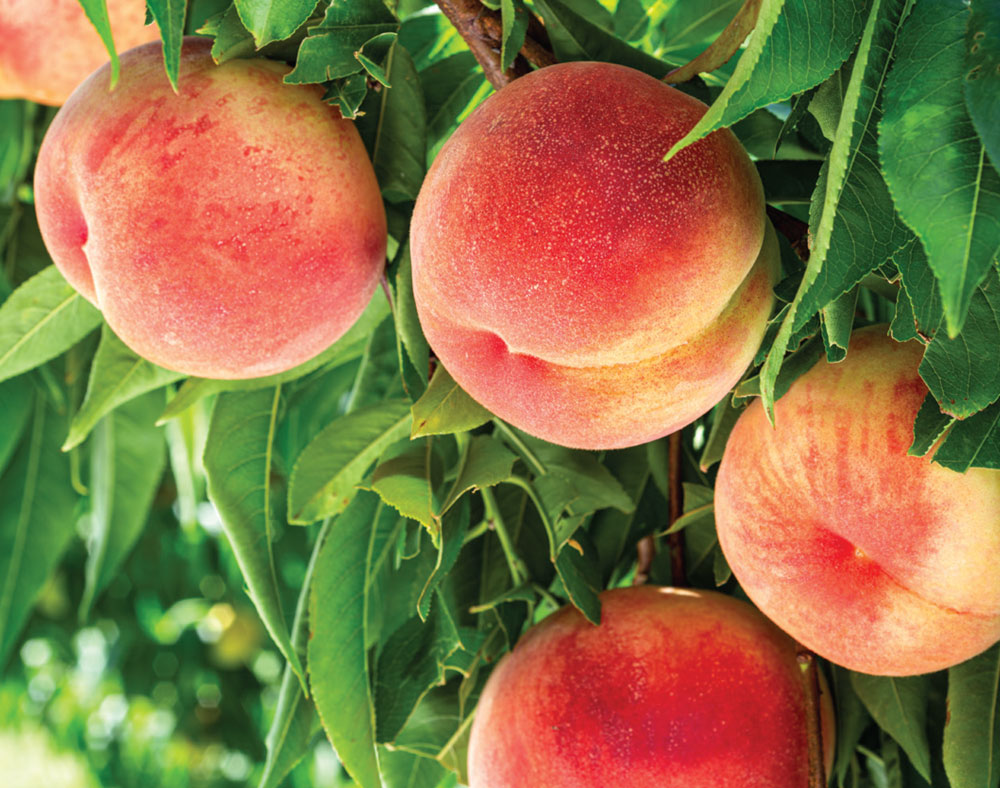 Around the world
Around the world
Today, peaches can be found growing around the globe. There are thousands of varieties worldwide, with at least 300 of them grown in the United States. Because there are so many varieties, no single one has risen to become the standout. Peaches are generally labeled by the tone of their flesh (white or yellow although there are also red peaches out there) and grouped into categories according to its relationship with the stone in the center of the fruit. Clingstone, freestone and semi-clingstone are the classifications used to describe how the fruit of the peach clings to the pit containing its seed. There’s also the donut-shaped peach, a small flat peach with a dimpled center that leads them to resemble a donut.
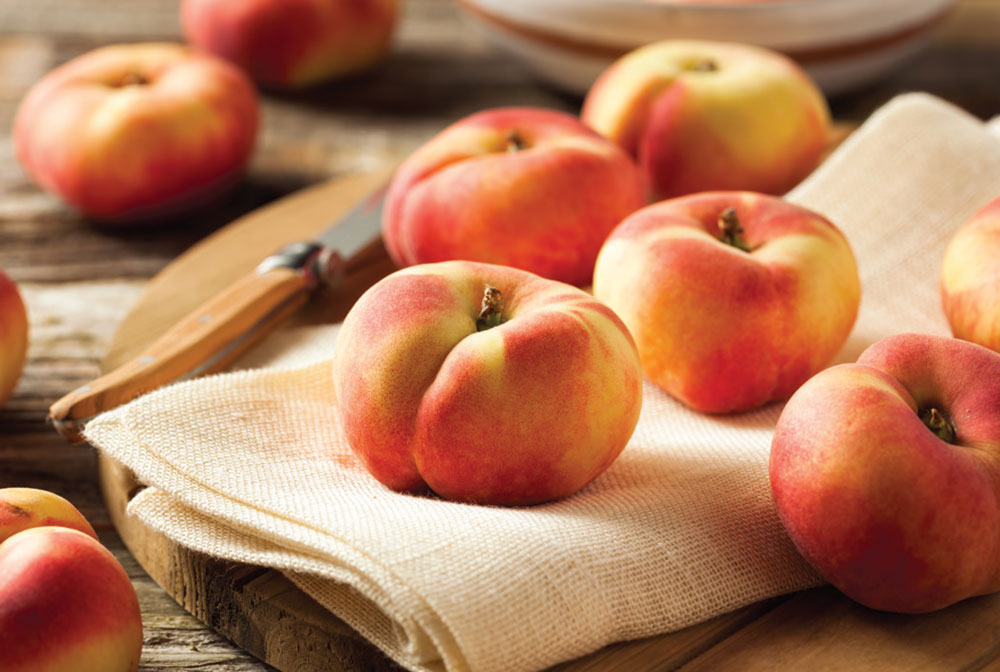 The nectarine, which is often thought of as a relative of the peach, is actually a naturally occurring genetic mutation of the peach. The fuzz is carried on a recessive gene, which nature sometimes deletes. This is how you can occasionally find nectarines growing on the same tree as peaches.
The nectarine, which is often thought of as a relative of the peach, is actually a naturally occurring genetic mutation of the peach. The fuzz is carried on a recessive gene, which nature sometimes deletes. This is how you can occasionally find nectarines growing on the same tree as peaches.
Georgia may be known as the peach state, but it falls behind South Carolina and California in production. Harvested by hand because they bruise easily, peaches are typically picked slightly underripe. They go through a cold-water bath to keep them from becoming overripened during shipping to their final destination. They can also be cleaned, defuzzed and culled in the packing process.
In Virginia
Here in Virginia, we are lucky to have several local orchards, including some pick-your-own farms. Clingstone peaches come into season first, as early as late May/early June, with semi-clingstone and freestone varieties arriving later in the season. Our peak peach harvest here in Central Virginia is July and August, although they remain available until around the middle of September at many local orchards. There are those who claim clingstone peaches have a better flavor, but freestones are decidedly much easier to work with in bulk. If you’ve ever tried to peel and slice a slightly underripe clingstone peach, you know that they are a bit of a beast to deal with.
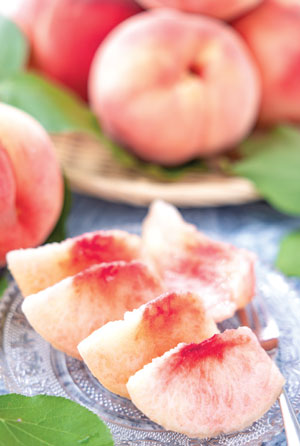 White or yellow?
White or yellow?
Historically, white fleshed peaches were considered inferior to the yellow ones. It wasn’t until the 1980s that white peaches started to make a name for themselves. Delicate in flavor, slightly floral and less acidic, white peaches are sweeter than their yellow counterparts. That lower acid content makes the sweetness more pronounced, removing that tangy bite we associate with peaches. It also makes them unsuitable for preserving, other than freezing, without adding a lot of citric acid, which can affect the taste.
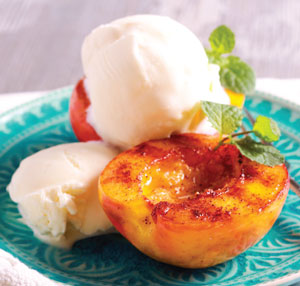 It’s that acidic sweetness that allows peaches to be used in a wide range of dishes. Toss them with other fruits and/or herbs for a quick fruit salad. Grill them until they start to caramelize and serve with ice cream for a wonderful summer dessert. Swap out the ice cream for goat cheese for a savory side dish.
It’s that acidic sweetness that allows peaches to be used in a wide range of dishes. Toss them with other fruits and/or herbs for a quick fruit salad. Grill them until they start to caramelize and serve with ice cream for a wonderful summer dessert. Swap out the ice cream for goat cheese for a savory side dish.
Peaches can be substituted for tomatoes in a wide range of recipes — salsa, caprese salad, gazpacho, panini or paired with pesto, even as a base for barbeque sauce. They pickle beautifully, as first discovered by the Romans as evidenced in a cookbook “De Re Coquinaria” published around 14-37 AD. Of course, there’s always the classic ways to eat peaches — out of hand, tucked into ice cream, baked into a pie or cobbler or preserved in a jam.
When purchasing peaches, look for a consistent gold-to-yellow under color. Any red or blush to the exterior of the peach is a product of variety, not ripeness. If the skin has any green shading to it, it is still underripe. They should be soft to the touch, not bruised or mushy. Underripe peaches can sit on a counter for a few days to ripen or place them in a paper bag for a few days to help with the process. Once fully ripe, peaches should stay good in the refrigerator for up to a week.
To peel peaches, a simple blanching usually will suffice. Cut a small X on the bottom before dropping them into a pot of boiling water for 30-60 seconds, following with an ice bath to stop the cooking process. The skins should peel off easily with this process. I will warn you, however, that underripe peaches do not like to give up their skin even with this treatment, so you may still find yourself reaching for that peeler to assist in your task. Toss peaches with a little lemon juice to keep them from browning.
Peaches are nutritional powerhouses, low in calories while filled with vital vitamins (A and C), minerals, anti-oxidants and fiber. Their slight tanginess lends them to working in a wide range of recipes.
 Peach Mint Salad
Peach Mint Salad
This effortlessly easy dish is perfect for summer picnics and potlucks, especially when everyone else is showing up with caprese salads. Photo: James River Media
- 2-3 peaches
- Mint (a stalk, maybe two), chopped
- Squeeze of lemon (about a quarter of a fresh lemon)
- Sweetener (about a teaspoon of sugar or honey)
Peel and dice peaches. Toss with lemon juice — I like to use fresh, but a dash of bottled works. Add a spoonful of sweetener — sugar works, as does a spoonful of honey. Add a good handful of chopped mint and mix well. It can be served immediately, but if using slightly under-ripe peaches, let sit for about an hour or more.
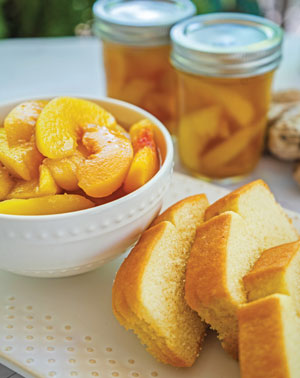 Pickled Peaches
Pickled Peaches
Pickled peaches, an old-fashioned Southern recipe, can be made as quick pickles or put them in a hot water bath for longer shelf storage. Pickled peaches can be substituted for fresh or canned peaches in pie or a pound cake. They are absolutely fantastic served alongside grilled meat, particularly pork. Photo: James River Media
- 3 pounds peaches
- 500 mg vitamin C tablets (if using fresh peaches)
- ½ cinnamon stick
- 1/8 teaspoon whole cloves
- 1 1/2-inch piece of fresh ginger, cut in large chunks
- Cheesecloth bag
- 1 cup white vinegar
- ¾ cup water
- ¾ cup sugar
- ¼ teaspoon ground allspice
If using fresh peaches, in large non-reactive bowl, crush 500 mg of vitamin C tablets, and combine with 2 quarts cold water. Blanch peaches, then peel, pit and quarter them, dropping into the prepared bowl to keep peaches from browning. (If using frozen peaches, skip this step.)
Place cinnamon stick, cloves and ginger in a cheesecloth bag. Combine the vinegar, water, sugar, allspice and bag of spices in a nonreactive pot. Bring to a boil, stirring to dissolve the sugar. Reduce heat, and simmer for 10 minutes. Add the peaches, and gently simmer until they are just heated through.
Pack the peaches into clean, sterile jars. Pour the hot syrup over the peaches, leaving ½” headspace. At this point, you can hot-water bathe the jars for 20 minutes if you want them to be shelf stable. Or, let cool, and keep in the refrigerator.
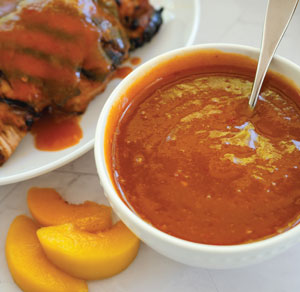 Peach Barbeque Sauce
Peach Barbeque Sauce
(Adapted from Preserving by the Pint by Marisa McClellan)
A lighter version than the classic tomato-based sauce, peach barbeque sauce is lovely on white meats such as chicken and pork, as well as fish. Feel free to experiment with adding more hot peppers if you like the heat. Photo: James River Media
- 2 pounds peaches
- ¾ cup cider vinegar
- ½ cup packed light brown sugar
- ½ cup minced yellow onion
- 2 garlic cloves, minced
- 2 teaspoons salt
- 2 teaspoons hot pepper flakes
- 2 teaspoons smoked paprika
Blanch, peel and halve peaches. Combine with remaining ingredients in a saucepan over medium heat. Cover and simmer about 10 minutes, or until peaches and onions start to soften. Mash peaches, and continue to cook, uncovered, until mixture reduces by half, about 45 minutes. Use an immersion blender or food processor to purée mixture until smooth. Taste for seasoning. (Makes 1 pint of sauce.) ✦
china, Peach Barbeque Sauce, Peach Mint Salad, peaches, pick-your-own farms, Pickled Peaches
